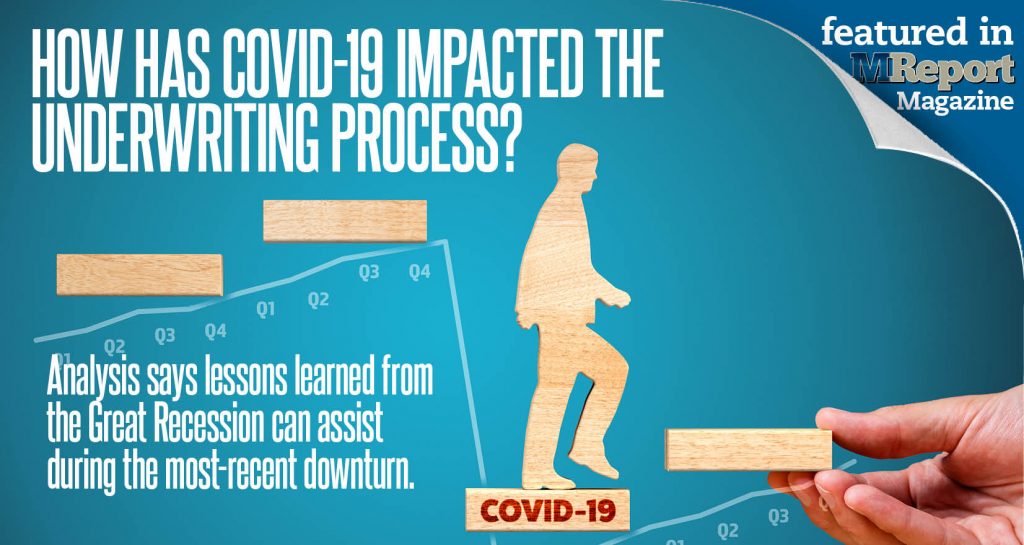
This story originally appeared in the July edition of MReport.
Over the last few months, COVID-19 has taken the world by storm, causing individuals and businesses to change their day-to-day processes to ensure everyone remains safe and healthy. While this is not business as usual, it’s still business—simply with differ-ent processes and guidelines in place.
Just as with other industries and sectors, underwriting has seen an impact from the virus that makes the day-to-day a bit more difficult and uncertain. Between changes in borrowers’ employment, delays in tax filing, and ensuring all information is up to date, underwriting has become more of a “real-time” process. Reaching nearly 15%, unemployment has increased to levels not seen since the Great Recession, and while many businesses are beginning to open, there are still some areas that have remained closed, with layoffs and furloughs as a result.
A lot can happen in 30 days, including changes to a borrower’s employment status and income. For lenders, it is vital to proactively and regularly gauge changes in the status of the borrower and to ensure all things are in place to make for easy and successful closing. For servicers, it is just as important to stay abreast of information on any type of leniency to assist borrowers that may be facing hardship.
Keep in mind that loose underwriting practices contributed to the last recession, so lenders should work to keep the lessons learned from those mistakes at the forefront of each transaction to avoid repeating past mistakes that resulted from not instilling strict guidelines or doing regular checkups to make sure that the borrower is still a good fit for the loan. Without meeting the guidelines, both the lender and borrower could be in a tough position that causes the mortgage to fall through, go into default, and ultimately create a difficult and stressful situation for both parties.
Additionally, there needs to be a form of flexibility to work with borrowers that may have asked for forbearance previously, have temporarily reduced income, or have experienced other circumstances that would still allow them to obtain a loan that is ultimately not too risky for either lender or borrower. Forbearance has been in high demand due to COVID-19. According to Black Knight, 8.8% of home loans and 47 million homeowners are under forbear-ance.
This means that lenders need to make sure they have viable candidates for loans and should look into the borrower’s current mortgage status to make sure they are not seeking a new loan while simultaneously asking for forbearance or modification. While navigating this new landscape, what should be taken into consideration during the underwriting process to ensure a smooth closing? Let’s discuss a few tips and tricks.
The Need for Extra Assurance
Financial situations can change in an instant. Many companies are seeing hardships, which translate into changing the employment status of their employees. Whether it means terminating employees, implementing fur-loughs, or making cuts in commissions, the virus has shown us all that nothing is certain. For lenders to ensure they are providing a loan to a viable buyer, additional steps are needed in the underwriting process. A lot can happen between origination and closing.
For many origination documents, the traditional age requirements still may be sufficient, even in this environment. However, with last-minute changes in employment status or credit, a deal can be off the table or become an issue later if the buyer has significant changes in their status. We are seeing more frequent “check-ins,” including during the post-underwriting timeframe, to make sure nothing has changed. There also are a few steps lenders should integrate to prevent any hiccups down the road that can interrupt the loan, potentially push it into default, or result in a costly repurchase.
Steps Lenders Should Take
The underwriting process consists of many moving parts and 30 days can go by rather quickly. It is the lender’s duty to make sure all origination documents are current and meet guidelines. In order to do so, lend-ers should check borrowers’ credit profiles and utilization more frequently. Significant changes in credit can be good indicators that there may be changes in employment or financial circumstance.
For instance, if a credit card becomes maxed out, the borrower has high utilization, or if they apply for a new credit card, that could be an indication their income or employment status may have changed. Therefore, we are seeing more frequency in looking into borrowers’ current situation closer to the closing date. Utilizing tools that are more up to date to monitor the spending behaviors for things like credit cards is a good way to determine the status of a borrower.
We are seeing lenders perform credit checks and verify employment information a minimum of fewer than 10 days before—if not the day of—closing to make sure there aren’t any significant financial changes and to confirm that the borrower is still in good standing. If their status has changed, the loan and closing process could come to an end prior to reaching the closing table. For borrowers that may be self-employed or have a nontraditional type of work, the process is a little different because it takes longer to verify current status. Because of that, it is important to utilize alternative means to verify employment.
What COVID-19 also has done is extend the tax filing date to later this year, which has important implications for lenders. With tax filing being put off until the middle of July, it makes it more difficult for lenders to identify the income levels that allow them to provide a loan if the borrower does not file their taxes prior to the deadline. For lenders, this means that frequency and proactivity is their friend. Knowing that the borrower is not their typical situation, they must be sure to collect information early on and look into different ways to obtain current income tax information that is more up to date since the filing is delayed. Given the circumstances, year-to-date company profit and loss statements and monthly business bank statements are becoming more common documentation to obtain for self-employed borrowers.
Understanding Unique Situations
One other key part of navigating the underwriting process during COVID-19 is taking into consideration those unique circumstances to ensure the business continues as expected. Like previously mentioned, some individuals work for themselves or they may have been furloughed. While this makes verifying their current financial situation more challenging, it does not necessarily mean that they are no longer viable for a loan.
However, it does mean that the loan terms may change to ensure the lender is not underwriting a loan with excessive risk or giving rights to a property that a borrower can no longer afford. Especially while interest rates are low, the number of borrowers applying to refinance has increased. While this is a great opportunity for the borrower, they must be careful about how they go about refinancing and if they are simultaneously looking into a new loan and property. As a lender, it is important to investigate the previous or current status of loans from other lenders to make sure there isn’t any alarm-ing activity. For instance, if the borrower currently has forbearance on their previous mortgage and is seeking a new loan, that will impact the new loan indefinitely.
Seeking Flexibility for Borrowers
For a lender, while they need to continue the business of providing loans, they also must make sure the loans show no signs of going into default. The lender must also look out for the borrower and make sure they do not get into a situation that could cause financial ruin later. Lenders also should remain up to date on the latest guidelines that have been adjusted due to COVID-19. There is some flexibility to make sure that individuals that are impacted by the virus can still obtain a mortgage, but it requires some extra work from the lender.
For lenders, this is the time to make sure that all avenues are being explored like adjusting loan terms and working with the borrower to make sure there is not a complete halt on their intentions of purchasing a home. Work with your peers to stay informed on what types of guidelines have changed due to the virus and look into flexible options to continue the business.
Underwriting Post-COVD-19
It is uncertain as to when things will return to “normal,” or if things will ever be the same. Some industries have been hit harder than others and as a result will see changes, like the mortgage industry. For lenders, it is now part of their job to look more closely at the borrower’s eligibility and go the extra mile to confirm that the borrower’s status hasn’t changed during the closing process. It also is important to make sure that there are options to be able to facilitate loans under these different circumstances. The underwriting process has seen many significant changes and will continue to do so. Lenders must now and in the future be sure to have their ducks in a row to ensure both borrower and lender are viable and protected during and after COVID-19.

 theMReport.com Your trusted source for mortgage banking news
theMReport.com Your trusted source for mortgage banking news









